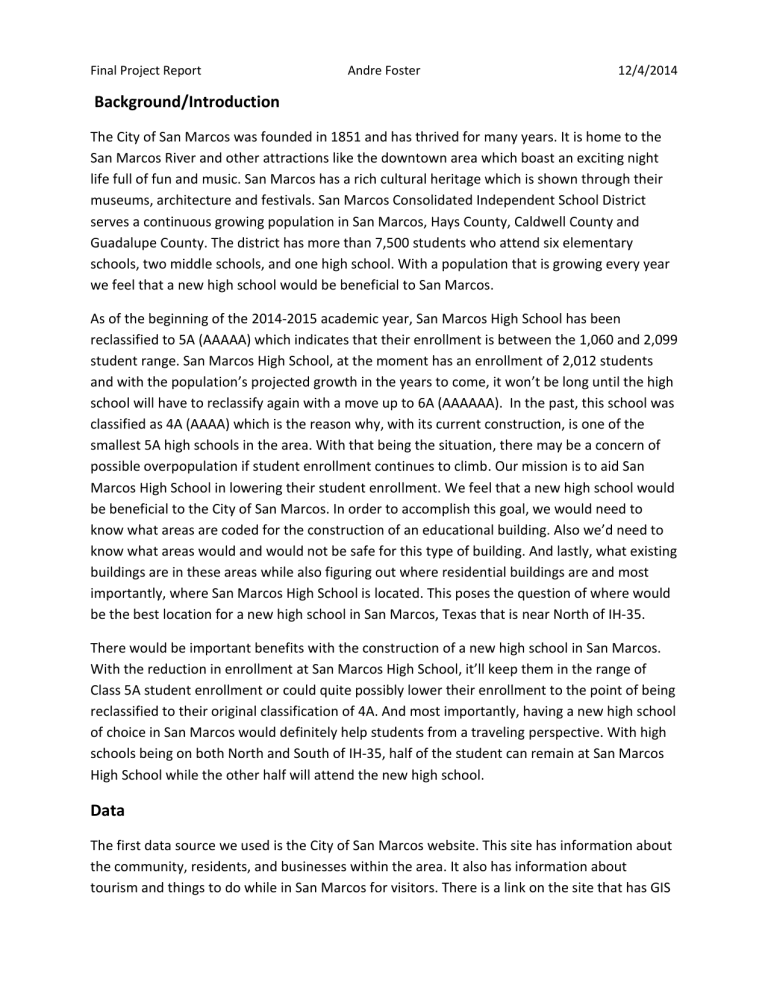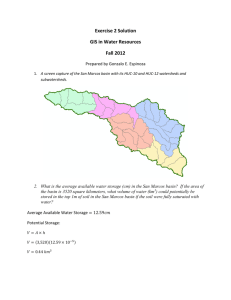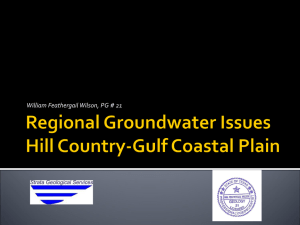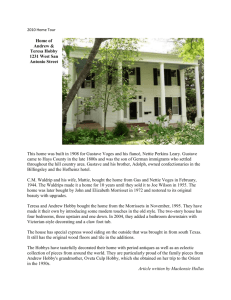Background/Introduction

Final Project Report
Background/Introduction
Andre Foster 12/4/2014
The City of San Marcos was founded in 1851 and has thrived for many years. It is home to the
San Marcos River and other attractions like the downtown area which boast an exciting night life full of fun and music. San Marcos has a rich cultural heritage which is shown through their museums, architecture and festivals. San Marcos Consolidated Independent School District serves a continuous growing population in San Marcos, Hays County, Caldwell County and
Guadalupe County. The district has more than 7,500 students who attend six elementary schools, two middle schools, and one high school. With a population that is growing every year we feel that a new high school would be beneficial to San Marcos.
As of the beginning of the 2014-2015 academic year, San Marcos High School has been reclassified to 5A (AAAAA) which indicates that their enrollment is between the 1,060 and 2,099 student range. San Marcos High School, at the moment has an enrollment of 2,012 students and with the population’s projected growth in the years to come, it won’t be long until the high school will have to reclassify again with a move up to 6A (AAAAAA). In the past, this school was classified as 4A (AAAA) which is the reason why, with its current construction, is one of the smallest 5A high schools in the area. With that being the situation, there may be a concern of possible overpopulation if student enrollment continues to climb. Our mission is to aid San
Marcos High School in lowering their student enrollment. We feel that a new high school would be beneficial to the City of San Marcos. In order to accomplish this goal, we would need to know what areas are coded for the construction of an educational building. Also we’d need to know what areas would and would not be safe for this type of building. And lastly, what existing buildings are in these areas while also figuring out where residential buildings are and most importantly, where San Marcos High School is located. This poses the question of where would be the best location for a new high school in San Marcos, Texas that is near North of IH-35.
There would be important benefits with the construction of a new high school in San Marcos.
With the reduction in enrollment at San Marcos High School, it’ll keep them in the range of
Class 5A student enrollment or could quite possibly lower their enrollment to the point of being reclassified to their original classification of 4A. And most importantly, having a new high school of choice in San Marcos would definitely help students from a traveling perspective. With high schools being on both North and South of IH-35, half of the student can remain at San Marcos
High School while the other half will attend the new high school.
Data
The first data source we used is the City of San Marcos website. This site has information about the community, residents, and businesses within the area. It also has information about tourism and things to do while in San Marcos for visitors. There is a link on the site that has GIS
Final Project Report Andre Foster 12/4/2014 information under Departments. From there you are able to go to the Map Library in which you will see a list of Static Maps and GIS Data. In the GIS Data list we were able to individually download the San Marcos City Limits with Extraterritorial Jurisdiction, Buildings, Floodplains, and Zoning. We wanted to keep all Buildings but out of that dataset we created two new layers to show Residential Buildings and San Marcos High School. Within the Zoning dataset, we only needed to know what areas we could possibly build a new high school on. The only areas coded for the construction for a school are Public/Institutional so we created that one layer from the
Zoning dataset. The dataset of City Limits and Extraterritorial Jurisdiction came together in a zip file but we would only need the City Limits. And lastly, the Floodplains dataset came with layers of 100 year and 500 year in which we found both to be useful.
The second data source we used is the Hays County website. This site has information about the community of Hays County, the Commissioners Court, Districts, Law Enforcement, different
Offices in Hays County, and Career Opportunities within the area. There is a link on the site that has GIS information under Offices and Development Services. Within the shape file folder we were able to download Hays County Roads. We only needed the Roads that were within the
City Limits of San Marcos and the Road of IH-35 so we created two new layers from it.
Methods of Analysis
The first assessment we conducted was of the Roads of San Marcos. Ease of access to the school was a priority but the main issue we wanted to address with the roads was to know what area North of IH-35 we would like to build the new high school. In order to determine the split of IH-35, we performed a ‘Select by Attributes’ on the Roads shape file in which we were able to create two new layers, North IH-35 and South IH-35.
The second assessment we conducted was of the Zoning within the San Marcos City Limits to see what areas are coded for educational buildings. The only zone that was need is
Public/Institutional. In order to extract that one zone from the 28 available in the shape file, we used the feature ‘Select by Attributes’ which helped us to create a new layer showing the areas in San Marcos that would allow the construction of a new school.
The third assessment we conducted was of the Floodplain areas in San Marcos. The two
Floodplains of 100 year and 500 year expanded well past the City Limits but we only needed what was within it. In order to accomplish that, we conducted a ‘Clip’ to show the Floodplains within the City Limits which created a new Floodplain layer for both 100 year and 500 year.
The final assessment we conducted was of all the Buildings within San Marcos. We also need to know where Residential Buildings were at and exactly where San Marcos High School was
Final Project Report Andre Foster 12/4/2014 located. To do that, we again performed a ‘Select by Attributes’ on the Buildings shape file. We were then able to create two more layers along with the original Buildings layer.
Results
Our first map (refer to Figure 1.1) focuses on the zoned areas for Public/Institutional (PI). PI zoning districts are intended to apply to publicly owned property, property owned by quasipublic or public service entities, and property used or planned to be used for certain institutional
facilities. The land uses for PI zoning includes the following:
Government services
Libraries and museums
Emergency shelters
Air transportation facilities
Cemeteries
Clubs, lodges, and meeting halls
Community centers
Maintenance and service facilities
Public safety facilities
Recreational facilities, public
Religious facilities
Schools
Transportation terminals
Utilities, major
Gravel mining
Obviously, since we are looking for the best location to build a new high school, a PI zoned area was needed. Within the City Limits of San Marcos, there is multiple PI zoning districts which would give us a variety of options. But since we are looking to build the school North of IH-35, we would more likely have to cut that number in half.
With the PI zoning districts in San Marcos now shown, we then focused our attention on the second map (refer to Figure 1.2) which includes the Floodplains of 100 year and 500 year. A floodplain is an area at risk for flooding from a bayou, creek or other waterway overflowing during certain theoretical floods, namely the 1 percent (100 year) and 0.2 percent (500 year) floods, and from coastal flooding caused by storm surge from tropical storms or hurricanes. A 1 percent (100 year) floodplain is an area that has a minimum of a 1 percent (1 in 100) chance of flooding in any given year from a bayou, creek or other waterway overflowing. A 0.2 percent
(500 year) floodplain is an area that has a minimum of a 0.2 percent (1 in 500) chance of
Final Project Report Andre Foster 12/4/2014
flooding in any given year from a bayou, creek or other waterway overflowing. With that information and understanding that it would not be ideal to build a school in an area that could possibly flood, we then wanted to figure out how many of the PI zoning districts would be covered by Floodplains. This prompted us to exclude a portion of the PI areas available.
The third map (refer to Figure 1.3) shows all Buildings within the City Limits of San Marcos. The purpose of having all buildings show is to make sure we don’t select an area that already has a building present. We then wanted to know out of those buildings, which ones were residential so we can have an idea of what areas are densely populated with residents rather than business buildings or other types of buildings. Also, we need to know the location of San Marcos High
School in which we found that it is located South of IH-35. This is why it was important for us to find a location that was on the opposite side (North of IH-35) to build the new school. To show
North and South IH-35, we split the road up according to its direction.
Conclusion
We initially wanted to know what areas are coded for the construction of an educational building in which we found out was the Public/Institutional zoning area. We then needed to know what areas would and would not be safe for this type of building which is why we used
Floodplains of 100 year and 500 year to decide that. With 89 PI zoning areas to select from we knew that our options were plentiful. But with about 32% of those PI zoning areas covered by
Floodplains, we excluded 28 of them which would dwindle our options to 61 locations. Finally, we needed to see where existing buildings were at which helped us figure out where residential buildings resided. This also revealed that San Marcos High School was located South of IH-35.
With all variables considered, we decided the best location to build a new high school would be
North of I-35 on an open land across from Dakota Ranch Apartments off of Old Ranch Rd 12
(Crestwood Rd).
Final Project Report Andre Foster 12/4/2014
(Figure 1.1)
Final Project Report Andre Foster 12/4/2014
(Figure 1.2)
Final Project Report Andre Foster 12/4/2014
(Figure 1.3)
Final Project Report Andre Foster
References
12/4/2014
Price, M.H. (2013), Mastering ArcGIS, 6th Edition. New York, NY: McGraw-Hill
Science/Engineering/Math
Jensen, J.R., Jensen, R.R. (2012), Introductory Geographic Information Systems. Glenview, IL:
Prentice Hall www.ci.san-marcos.tx.us www.co.hays.tx.us http://www.harriscountyfemt.org/Floodplains.htm http://www.codepublishing.com/ca/Cloverdale/html/cloverdale18/Cloverdale1807.html





